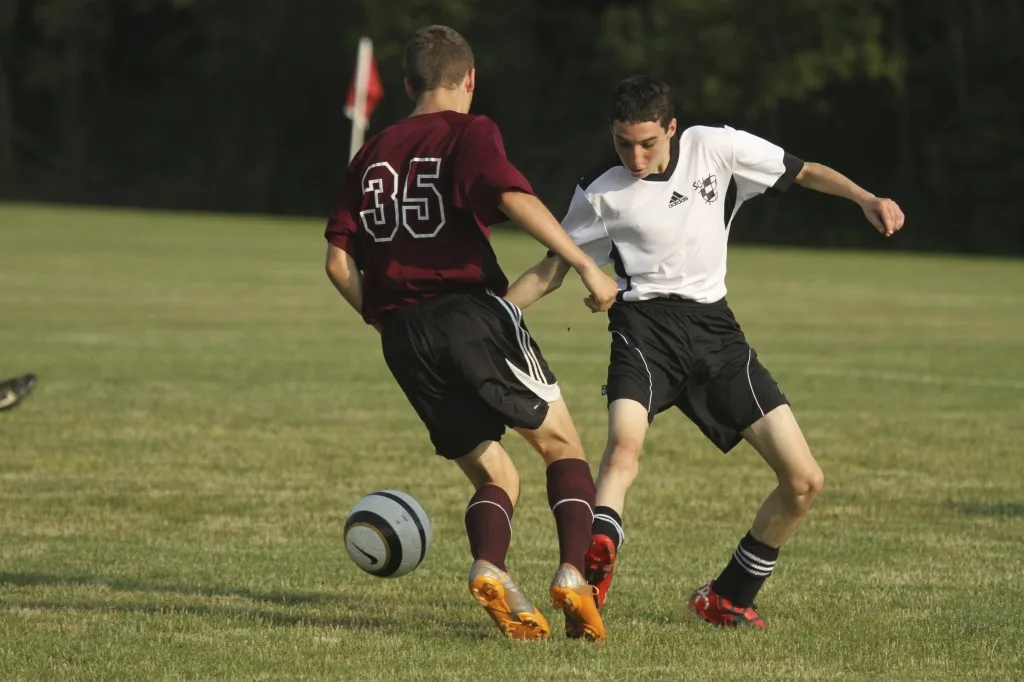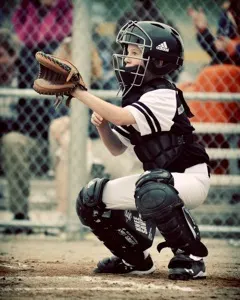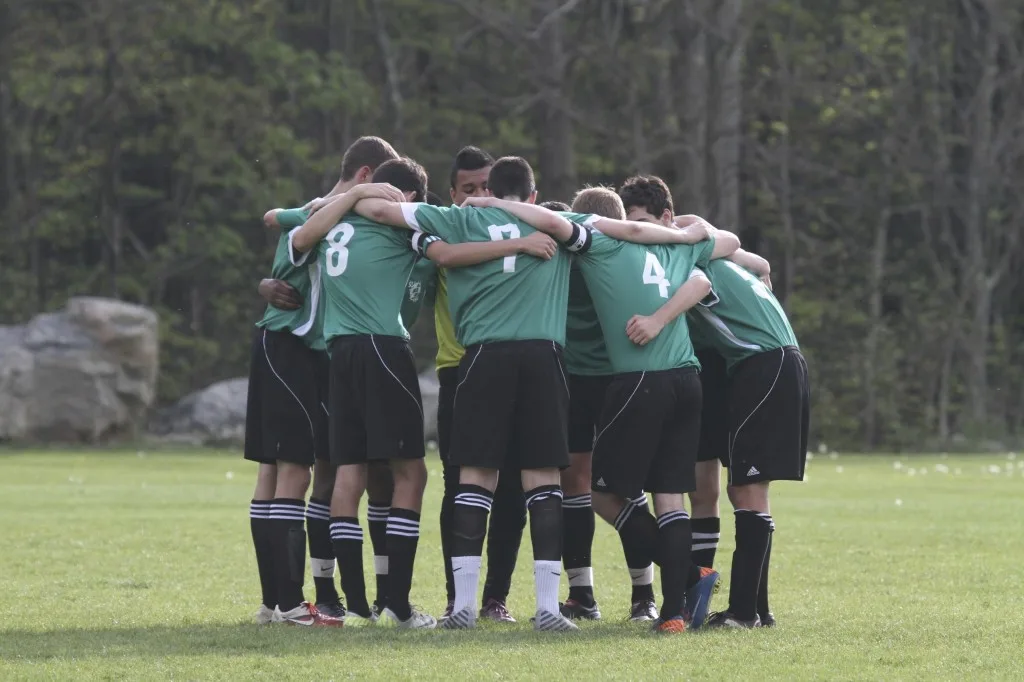With the fall sports season already underway, many of us (myself included) will be watching from the sidelines and taking pictures of our children’s sports endeavors. While the type of camera and lens you are shooting with will certainly affect the quality of your pictures, there are a number of other things as well that can help you improve your sports photography.
- Know how to use your camera. This little tip can make a huge difference in your pictures. Your instruction manual is a wealth of information. If you’ve misplaced it, you should be able to download one online. I refer back to mine often!
- Know the basics about your sport. I’m not suggesting you become an expert on the game. I’ve been watching my kids play soccer for 10 years now, and I’m still confused by some of the calls. But you should have a basic idea of what is going to happen during a game for the best action shots. Following the action is generally a good rule to follow. For example, if you’re taking pictures at a cross country race, you should know where the course goes and scope out ahead of time the parts of the course where you are likely to get the best shots. If you’re shooting a soccer game, you’re going to follow the path of the ball. Many people use monopods or tripods for action shots. I usually do not, because I prefer to have more flexibility of movement. But they can make a difference in the quality of the shot.
- Get as close as you can to the action and crop in tight. It can be distracting if you’ve got a lot of extra background in a photo. You can crop in with your editing software if you need to, but just keep in mind you will lose pixels and that affects the quality of the picture if you intend to blow it up to a larger size.
- When taking action shots, try to avoid tilting your camera too much. While pictures with the horizon tilted can sometimes look artistic, I find that it never seems to look right in sports situations. In the event that you do tilt your camera a little too much while you are shooting, your editing software may allow you to straighten the picture when cropping.
- Use a fast shutter speed. If your camera has a sports mode, you can use that. You’ll need a fast shutter speed to freeze the action. The shutter opens and closes quickly with a fast shutter speed, letting in less light. In sports photography, you may want to experiment once in a while using a slower shutter speed to blur the motion.
- Consider using a shallow depth of field. If you’d like to isolate your subject and blur the background, you’ll use a large aperture (or small f-stop) to create a shallow depth of field.
- Choose the right ISO. You can change your ISO setting to meet your light sensitivity needs. The less light, the higher ISO you will need to use. On a sunny day, you’ll want to use a low ISO like 100 or 200. At night games, you’ll need to use a high ISO, such as 1000 or 1600, which will allow you to stop the action in the lower light. You may find you need to experiment a little for best picture quality. Keep in mind that using a higher ISO will often cause a “grainy” look when printing or enlarging, so you should try to use a lower ISO if at all possible.
- Experiment with your white balance. The AWB setting is automatic white balance. That means the camera decides for you. Experiment a little…you may want to try the daylight and cloudy settings. I find that I use these two settings quite a bit when shooting outdoor games. I also often use custom white balance, especially for indoor sports, like basketball and swimming.
- Use continuous shooting. I love continuous shooting. With my camera, I can take up to 8 shots in a second and get a whole sequence of action. While you probably don’t need to save each picture in the sequence, you’ll improve your odds of getting that great picture!
- Consider using a lens hood. Most of the time you will get a perfectly good picture without a lens hood, but it stops unwanted light from creeping into your picture from the sides, which reduces contrast and creates lens flare. A lens hood also protects the lens from fingerprints and absorbs some of the shock from accidental blows to the lens. Lens hoods are fairly inexpensive when you consider the price of your lens, so its definitely worth having. I recently read this article by Improve Photography that gives an in-depth discussion on why you should use a lens hood, which you may find helpful.
- Don’t forget to take the shots that tell the rest of the story as well! The group huddle, cheering from the bench, high fives, the look on the players’ faces when a goal is scored…these are all integral parts of the story. Capturing emotions adds to the story! These pictures are just as important as the action shots…perhaps even more so! They show team camaraderie and bonding, which is what the kids tend to remember anyway, more so than their win-loss record.
I find that in order to get great action photos throughout the game, I end up watching the game through my viewfinder. For some parents, that’s hard to do. I’ve heard many parents say they feel like they miss part of the game when they take pictures. For me, I find it more relaxing. It focuses me more on the action and emotions, rather than what’s happening on the sidelines. If you want to take pictures but feel like you are missing out, try shooting just part of the game. When it all comes down to it, youth sports are about the team camaraderie, learning how to work together, and sportsmanship…important moments to record for your children.
*Special thanks to Mary Moseley from the Memory Boutique for sharing one of her photos with me for this post!





Rachael
Monday 13th of May 2013
Awesome! Thanks for the tips....I need to get a good camera and stop taking them on my phone! LOL
Michelle Nahom
Wednesday 15th of May 2013
Love my DSLR but the phone is good for certain things too! And you can get some cool little lens for your phone now too...who knew? I've picked up a few from photojojo! I love my photography toys!
Rabia
Monday 13th of May 2013
Back when I had a real camera (instead of just my phone) I used continuous shooting all the time. It's great for kids, because while they are being silly, you just keep shooting away and you are bound to end up with something useable! Not to mention, some great outtakes!!
Michelle Nahom
Wednesday 15th of May 2013
Oh I love continuous shooting! The good thing is when I am shooting soccer I get the entire sequence of the play and can choose the best picture or two and delete the rest. The bad thing is I might have 10 pictures from each sequence...which adds up to a lot of pictures. I maxxed out a 16GB card last weekend...lots of deleting to do there!
Nicole
Monday 13th of May 2013
Thanks for the great tips and awesome photos!
Michelle Nahom
Wednesday 15th of May 2013
It was a lot of fun taking them. Sometimes though when I get to all 3 kids games in a weekend, it can be overwhelming. Right now I have a bunch of photos to edit and send out to parents!
Karen
Monday 13th of May 2013
Thanks for the tips, I look forward to the day I get to watch my son play a sport. Happy SITS Day
Michelle Nahom
Wednesday 15th of May 2013
I enjoy watching them immensely. On Mother's Day they all had games and my youngest asked if I would come to his game...so I could take pictures! Oh melt my heart!